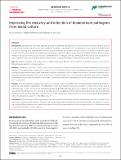Improving the recovery and detection of bloodstream pathogens from blood culture
Date
03/06/2020Metadata
Show full item recordAbstract
Introduction. Bloodstream infections (BSI) are growing in incidence and present a serious health threat. Most patients wait up to 48 h before microbiological cultures can confirm a diagnosis. Low numbers of circulating bacteria in patients with BSI mean we need to develop new methods and optimize current methods to facilitate efficient recovery of bacteria from the bloodstream. This will allow detection of positive blood cultures in a more clinically useful timeframe. Many bacterial blood recovery methods are available and usually include a combination of techniques such as centrifugation, filtration, serum separation or lysis treatment. Here, we evaluate nine different bacteria recovery methods performed directly from blood culture. Aim. We sought to identify a bacterial recovery method that would allow for a cost-effective and efficient recovery of common BSI pathogens directly from blood culture. Methods. Simulated E. coli ATCC 25922 blood culture was used as a model system to evaluate nine different bacteria recovery methods. Each method was assessed on recovery yield, cost, hands-on time, risk of contamination and ease of use. The highest scoring recovery method was further evaluated using simulated blood cultures spiked with seven of the most frequently occurring bloodstream pathogens. The recovery yield was calculated based on c.f.u. count before and after each recovery method. Independent t-tests were performed to determine if the recovery methods evaluated were significantly different based on c.f.u. ml−1 log recovery. Results. All nine methods evaluated successfully recovered E. coli ATCC 25922 from simulated blood cultures although the bacterial yield differed significantly. The MALDI-TOF intact cell method offered the poorest recovery with a mean loss of 2.94±0.37 log c.f.u. ml−1. In contrast, a method developed by Bio-Rad achieved the greatest bacterial yield with a mean bacteria loss of 0.27±0.013 log c.f.u. ml−1. Overall, a low-speed serum-separation method was demonstrated to be the most efficient method in terms of time, cost and recovery efficiency and successfully recovered seven of the most frequent BSI pathogens with a mean bacteria loss of 0.717±0.18 log c.f.u. ml−1. Conclusion. The efficiency of bacterial recovery can vary significantly between different methods and thereby can have a critical impact on downstream analysis. The low-speed serum-separation method offered a simple and effective means of recovering common BSI pathogens from blood culture and will be further investigated for use in the rapid detection of bacteraemia and susceptibility testing in clinical practice.
Citation
Falconer , K , Hammond , R & Gillespie , S H 2020 , ' Improving the recovery and detection of bloodstream pathogens from blood culture ' , Journal of Medical Microbiology , vol. 69 , no. 6 , pp. 806-811 . https://doi.org/10.1099/jmm.0.001209
Publication
Journal of Medical Microbiology
Status
Peer reviewed
ISSN
0022-2615Type
Journal article
Description
The research presented was supported and funded by the University of St Andrews, Scotland, UK.Collections
Items in the St Andrews Research Repository are protected by copyright, with all rights reserved, unless otherwise indicated.

